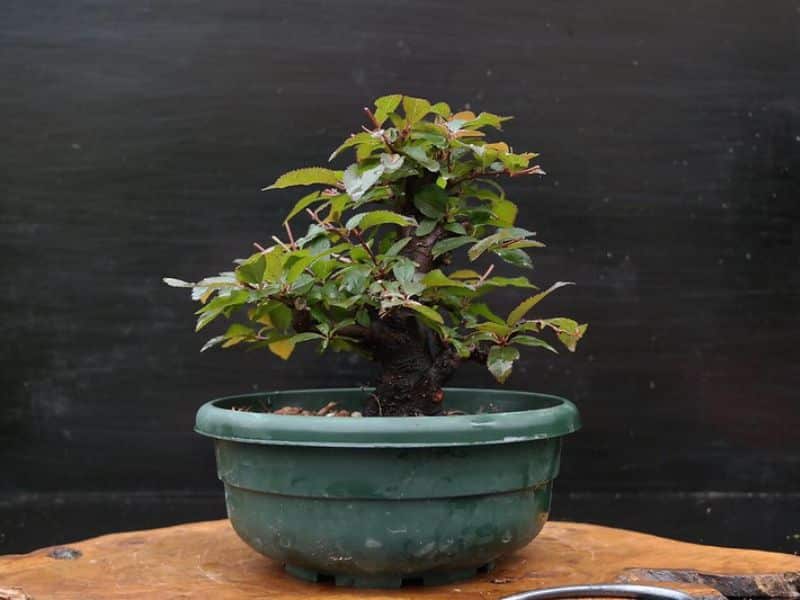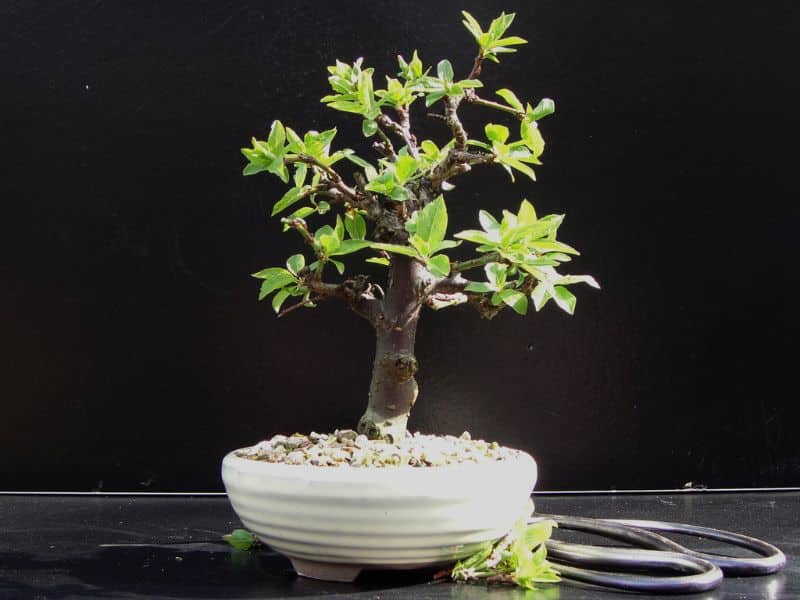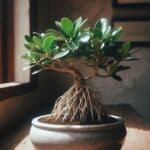The Chinese sweet plum (Sageretia theezans) is a popular tree species among bonsai enthusiasts. Growers adore this plant because it has small leaves and overgrows. It is also an attractive specimen plant since it has flaky texture-rich bark and produces striking pink or white blossoms that can transform into impressive purple fruits.
The plant has an excellent bonsai success rate, and it is ideal for everyone from a complete beginner to an advanced bonsai grower since it is so easy to care for.
The tree also has an extraordinary meaning since it symbolizes peace, harmony, and balance.
If you want to bring this powerful symbolism into your home or your very own flowering pet tree, then it is time to roll up your sleeves because we will show you how to grow this interesting specimen.

Plant Facts
| Scientific name | Sageretia theezans |
| Common names | Plum bonsai, sweet plum bonsai, Chinese sweet plum bonsai |
| Family | Rhamnaceae |
| Plant Type | Fruit tree |
| Height and Width | 7-10 ft. tall (natural), 1–3 ft. tall (bonsai) |
| Origin | Southern China |
| Flower colors | Pink or white |
| Foliage color | Light green |
| Sun Exposure | Semi-shade |
| Soil Type & pH | Well-drained, standard bonsai soil mix |
| Special features | Low maintenance, Good for containers, Beautiful pink or white blossoms |
What Does a Bonsai Plum Tree Look Like
Sageretia bonsai has a lot of attractive characteristics. This evergreen shrub is covered with vibrant green foliage throughout the year and tends to form a thick trunk covered in flaky bark.
The little tree can produce vivid pink or white blooms in the late summer with sufficient sun exposure. Small blue or purple fruits can follow this.
The tree species can be modified or trained into any bonsai shape. It is an excellent candidate for an informal upright or slating bonsai style.
Where to Grow a Plum Bonsai
The sweet plum is an indoor bonsai because it can be sensitive to intense heat or cold temperatures. This tree prefers a semi-shade position during warm summers. It is easy to keep the tree healthy indoors if you place it in a south or west-facing window where the direct sun is not too intense.
How to Grow a Bonsai Plum Tree
These purple bonsai trees are relatively easy to grow and train. They also have a fast growth rate and their thick bark will enable you to create a tree with a mature appearance within just a few years. Let’s take a look at the right steps for growing this interesting plant.

Propagation
Plum seeds don’t have an excellent germination rate. It is usually best to propagate this tree from cuttings or to acquire a young tree from your local nursery.
To propagate the tree from cuttings, you must take 3 – 6 inch-long shoots in the spring season. Clean the entire cutting, but leave a bit of foliage at the tip of the cutting. You can now plant the cutting in compost or potting soil.
Keep this small pot moist and humid. You can raise the humidity levels by placing a plastic bag or cover over the container. Allow the cutting to breathe regularly.
Remove the bag once new foliage develops and allow the cutting to form healthy roots before transplanting it.
Soil
Plum cuttings can be propagated by planting them in nutrient-rich potting soil. You can keep the cutting in this type of soil for the first year so the cutting can grow healthy and strong roots.,
Once the sapling is strong enough, it can be transplanted in a bonsai pot.
Plum bonsai trees can be planted in a standard bonsai soil mixture that drains well yet retains a bit of moisture. These trees don’t like dry conditions. To keep your tree from drying out, it can be best to plant it in a slightly larger container.
Pruning
The long trunk can be clipped short to encourage branching. Leave the main branches until they create a few nodes before cropping these branches short.
Pretty soon, these branches will start forming new shoots. These shoots can be clipped after the second node on each branch. This will encourage a more dense growth pattern for your little tree.
Sageretia bonsai can be pruned throughout the year and it is usually best to keep about two leaves on each new shoot that forms on the main branch structure.
The lead branches can be modified and shaped by wrapping them in aluminum or copper wire and bending them into place. This should be done in spring when the branches are still young.
If you want your little fruit tree to bloom then you should hold off on pruning from late summer onward.
Repotting and Transplanting
Sweet plum bonsai trees need to be repotted once every two years. They respond very well to root pruning and have a pretty high success rate for this stressful technique.
Remove the bonsai from its pot and trim back one-third of the root system. You can then replant it in fresh bonsai soil in a container with lots of drainage holes.
How to Care for a Bonsai Plum Tree
Plum trees are often recommended to bonsai beginners because they are pretty easy to care for. Let’s take a look at how to keep this indoor bonsai healthy and vigorous.

Water
This tropical tree prefers moist soil but shouldn’t be kept in sogg conditions. You should never let the roots dry out entirely since this can make the tree lose its foliage. Your little tree may even die if you never water it. It is also best to avoid calcareous water since the trees can be sensitive to these minerals.
Sunlight
The foliage can easily scorch in direct sunlight and the tree can die if the soil becomes too hot and dry. It is usually best to keep the tree in a partial sun position. An ideal spot is a sunny window with early morning or late afternoon sun.
Temperature and Humidity
The flowering bonsai tree can be susceptible to fluctuating temperatures. It prefers 53 – 72 degrees F or 12 – 22 degrees C. The tree should be protected and kept in a cool place in scorching areas. Keep the tree in the house or in a heated conservatory in cold regions.
Because it is a tropical plant, it also prefers high humidity levels. You can mist the leaves daily or place the tree in a humidity tray.
Fertilizer
The small evergreen will grow much better if it receives organic fertilizer once every four weeks or a liquid fertilizer once a week during the growing season. Fertilizing can be reduced during the winter time.
Pest and Diseases
It can be difficult to protect a sweet plum if it is positioned outdoors because all sorts of pests love to munch on these delicate trees. You should watch for pests like Plum sawflies, aphids, winter moths,s and scale insects. The tree can also be vulnerable to diseases or fungal issues like brown spot.
Common Varieties and Cultivars
The sweet plum or Chinese sweet plum (Sageretia theezans) is the most popular cultivar to use in bonsai creations because it has smaller leaves and produces small fruits.
There are, however, over 2000 different plum cultivars and most of them can be used for bonsai. The best alternative varieties for bonsai include the following:
- Damsons (Prunus domestica)
- Bullaces (Prunus insitiatia)
- Cherry Plums (Prunus cerasifera)
- Bird Plum (Berchemia discolor)
- Natal Plum (Carissa macrocarpa)
Conclusion
Sweet plums can be a lovely bonsai to grow, and they are an ideal pick if you want to develop a flowering bonsai that will look beautiful within just a few short years. This type of tree is easy to take care of but should never be neglected for too long because it can die if it dries out.
We hope you enjoyed our guide, and if you decide to try this flowering bonsai, we wish you all the best on your growing journey.
Up next:







